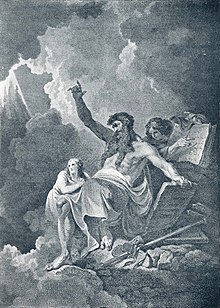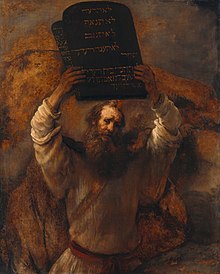
A | B | C | D | E | F | G | H | CH | I | J | K | L | M | N | O | P | Q | R | S | T | U | V | W | X | Y | Z | 0 | 1 | 2 | 3 | 4 | 5 | 6 | 7 | 8 | 9
| Part of a series on the |
| Ten Commandments |
|---|
 |
| Related articles |

The Ten Commandments (Biblical Hebrew: עֲשֶׂרֶת הַדְּבָרִים, ʿĂsereṯ haDəḇārīm, lit. 'The Ten Words'), or the Decalogue (from Latin decalogus, from Ancient Greek δεκάλογος , lit. "ten words"), are a set of biblical principles relating to ethics and worship originally from the Jewish tradition that play a fundamental role in Judaism and Christianity. The text of the Ten Commandments appears in three different versions in the Bible:[1] at Exodus 20:2–17, Deuteronomy 5:6–21, and the "Ritual Decalogue" of Exodus 34:11–26.
According to the Book of Exodus in the Torah, the Ten Commandments were revealed to Moses at Mount Sinai, told by Moses to the Israelites in Exodus 19:25 and inscribed by the finger of God on two tablets of stone.[2]
Scholars disagree about when the Ten Commandments were written and by whom, with some modern scholars drawing comparisons between the Decalogue and Hittite and Mesopotamian laws and treaties.[3]
Terminology

The Ten Commandments, called עשרת הדברות \ עֲשֶׂרֶת הַדְּבָרִים (transliterated aséret hadvarím) in Biblical Hebrew, are mentioned at Exodus 34:28,[4] Deuteronomy 4:13[5] and Deuteronomy 10:4.[6] In all sources, the terms are translatable as "the ten words", "the ten sayings", or "the ten matters".[7] In Mishnaic Hebrew they are called עשרת הדיברות \ עֲשֶׂרֶת הַדִּבְּרוֹת, aséret hadibrót, lit. "the ten sayings" or "the ten utterances".[citation needed]
In the Septuagint, the Greek translation of the Hebrew Bible was translated as δεκάλογος, dekálogos or "ten words"; this Greek word became decalogus in Latin, which entered the English language as "Decalogue", providing an alternative name for the Ten Commandments.[8] The Tyndale and Coverdale English biblical translations used "ten verses". The Geneva Bible used "ten commandments", which was followed by the Bishops' Bible and the Authorized Version (the "King James" version) as "ten commandments". Most major English versions use the word "commandments".[4]
The stone tablets, as opposed to the ten commandments inscribed on them, are called לוחות הברית \ לוּחוֹת הַבְּרִית, lukhót habrít, meaning the "tablets of the covenant".
Biblical narrative

The biblical narrative of the revelation at Sinai begins in Exodus 19 after the arrival of the children of Israel at Mount Sinai (also called Horeb). On the morning of the third day of their encampment, "there were thunders and lightnings, and a thick cloud upon the mount, and the voice of the trumpet exceeding loud", and the people assembled at the base of the mount. After "the LORD[9] came down upon mount Sinai", Moses went up briefly and returned to prepare the people, and then in Exodus 20 "God spoke" to all the people the words of the covenant, that is, the "ten commandments"[10] as it is written. Modern biblical scholarship differs as to whether Exodus 19–20 describes the people of Israel as having directly heard all or some of the decalogue, or whether the laws are only passed to them through Moses.[11]
The people were afraid to hear more and moved "afar off", and Moses responded with "Fear not." Nevertheless, he drew near the "thick darkness" where "the presence of the Lord" was[12] to hear the additional statutes and "judgments",[13] all which he "wrote"[14] in the "book of the covenant"[15] which he read to the people the next morning, and they agreed to be obedient and do all that the LORD had said. Moses escorted a select group consisting of Aaron, Nadab and Abihu, and "seventy of the elders of Israel" to a location on the mount where they worshipped "afar off"[16] and they "saw the God of Israel" above a "paved work" like clear sapphire stone.[17]
And the LORD said unto Moses, Come up to me into the mount, and be there: and I will give thee tablets of stone, and a law, and commandments which I have written; that thou mayest teach them. 13 And Moses rose up, and his minister Joshua: and Moses went up into the mount of God.
— First mention of the tablets in Exodus 24:12–13
The mount was covered by the cloud for six days, and on the seventh day Moses went into the midst of the cloud and was "in the mount forty days and forty nights."[18] And Moses said, "the LORD delivered unto me two tablets of stone written with the finger of God; and on them was written according to all the words, which the LORD spake with you in the mount out of the midst of the fire in the day of the assembly."[19] Before the full forty days expired, the children of Israel collectively decided that something had happened to Moses, and compelled Aaron to fashion a golden calf, and he "built an altar before it"[20] and the people "worshipped" the calf.[21]

After the full forty days, Moses and Joshua came down from the mountain with the tablets of stone: "And it came to pass, as soon as he came nigh unto the camp, that he saw the calf, and the dancing: and Moses' anger waxed hot, and he cast the tablets out of his hands, and break them beneath the mount."[22] After the events in chapters 32 and 33, the LORD told Moses, "Hew thee two tablets of stone like unto the first: and I will write upon these tablets the words that were in the first tablets, which thou breakest."[23] "And he wrote on the tablets, according to the first writing, the ten commandments, which the LORD spake unto you in the mount out of the midst of the fire in the day of the assembly: and the LORD gave them unto me."[24] These tablets were later placed in the ark of the covenant.[25]
Commandments text and numbering
Religious traditions
Although both the Masoretic Text and the Dead Sea Scrolls have the passages of Exodus 20 and Deuteronomy 5 divided into ten specific commandments formatted with space between them corresponding to the Lutheran counting in the chart below,[26][27] many Modern English Bible translations give the appearance of more than ten imperative statements in each passage.
Different religious traditions categorize the seventeen verses of Exodus 20:1–17 and their parallels in Deuteronomy 5:4–21 into ten commandments in different ways as shown in the table. Some suggest that the number ten is a choice to aid memorization rather than a matter of theology.[28][29]
